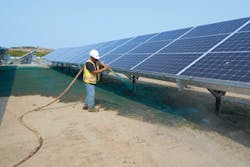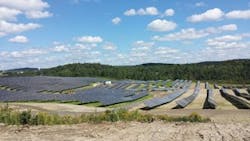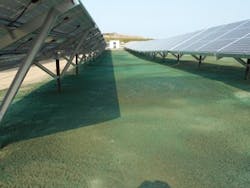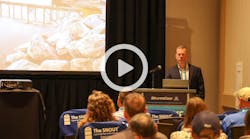Project Profile: Solar Panel Installation
Burks Falls West is a large 10-megawatt solar farm located near the beautiful Magnetawan River in the Armour Township of Ontario, Canada. The project is built on a generous 100 acres of natural rolling terrain and houses 40,000–50,000 solar panels. As the construction of solar panel project progressed, extreme challenges were experienced with erosion and sediment control. The project began to attract much attention, with growing concerns that it would possibly affect the quality of nearby waters and wildlife.
Unique to these solar panel projects, seeding works usually take place near the end of the project, and seed is required to be applied under, in between, and surrounding all areas of the solar panels. Seeding is a very important and required practice to establish new vegetative cover on newly graded and disturbed soils. During the entire site preparation process for the installation of the solar panels, the ground soil surface is disturbed and exposed. When sustained periods of rainfall occur, the ground soil is unprotected because of the complete lack of vegetation. It is during these periods that soil erosion and sediment movement become increasingly troublesome.
Such was the case with this solar farm construction. As issues began to escalate on site, the problems became politically sensitive for all parties involved on the project. To resolve the growing issues, the environmental consultant assigned to the project was compelled to search for and engage an experienced seeding contractor that could provide a quick and effective solution. The challenge: To minimize and manage the excess surface erosion and sediment movement by quickly and effectively establishing vegetation within a rapidly closing seeding window.
J. Lipani Turf Group from Queensville, Ontario, an experienced contractor with more than 50 years in growing sod and natural turf, was chosen to propose a remedial solution. Scottie Forbes, vice president of J. Lipani Turf Group, was quickly scheduled to meet onsite with the consultant and construction contractor to assess the severity of the problem. Forbes spent an entire day onsite and also discovered that previous seeding had been conducted by another seeding contractor. Unfortunately, these efforts were not providing effective results. One of the main issues observed, in addition to excessive soil erosion and sediment movement, was that the previous seed application lacked sufficient protection for new seed to germinate and establish itself without getting washed away every time rainfall occurred. The consultant and contractor revealed to Scottie that their priority at this point was to have an application that solved the erosion problem. After thoroughly assessing the property and acknowledging the many steep slopes, grade changes, and rolling terrain, Forbes decided on the quickest, most efficient, and most cost-effective way to approach the job.
A few options were considered to best deal with the issues at hand. One option was to use an erosion blanket material with seed. After sourcing and reviewing many products on the market, the J. Lipani team determined that an erosion control blanket was not the best solution. It was decided that the most effective and cost-effective product to use was Terrain Lok bonded fiber matrix (BFM) from Carolina Precision Fibers Inc., a company based in Ronda, NC.
A BFM is a biodegradable mulch product made up of layers of fiber strands that are held together by a water-resistant bonding agent. Its success in hydroseeding and erosion control is due to its ability to eliminate direct water impact on soil and to hold large quantities of water. In comparison to the blanket material, a BFM would be much more efficient due to the product’s full contact with the existing ground. “Using the bonded fiber matrix would involve less of a labor force to apply and in the long run would be less costly,” says Forbes. “I have had much experience with BFM products and they have given me the best results, especially on steep slopes and rolling terrain that are quite evident on this job site.”
Upon acceptance of the proposed solution, J. Lipani Turf Group mobilized onsite within one week. The seeding had to proceed as quickly and efficiently as possible, because to have seed germination and establishment of any degree, the seeding had to be performed within the growing season of mid-August to mid-October. “We had a 10-week window to cover an area that was approximately 100 acres, and we had to coordinate precise shipment dates for the Terrain Lok product to ensure no lack of product,” says Forbes. Despite J. Lipani being a new client, the relationship with Carolina Precision Fibers quickly grew to one of trust and cooperativeness. “Carolina provided the most competitive solution and their service was impeccable,” says Forbes.
To ensure completion of the job on time, two J. Lipani Turf Group hydroseeding machines were onsite for several weeks. The worked proceeded quickly. The environmental consultant and construction contractor were extremely pleased with J. Lipani’s progress and the performance of Terrain Lok BFM. Germination was taking place successfully in most areas, slower in areas where seeding was performed late in the season. In some places, the seed was applied in dormancy for the following spring.
It became clear that choosing an experienced seeding contractor such as J. Lipani Turf Group and using the Terrain Lok BFM were the right choices for the project. Terrain Lok enhanced the work to progress more smoothly and efficiently. The cleanup was easier, the material flowed consistently, and the spray pattern and coverage was notably superior to the products used in the past.
Evaluating the performance of the seeding works on the project, J. Lipani Turf Group took the opportunity to highlight that the seeding scope of work on these solar panel projects is of great importance and needs attention right from the beginning. Choosing an effective seed carrier such as Terrain Lok BFM with the right seed composition and applying them during the optimal period is a best practice to ensure vigorous and healthy vegetation. Planning and timing the seeding application methodically in conjunction with the other site preparations helps maximize protection from rainfall and minimize soil movement early on.




